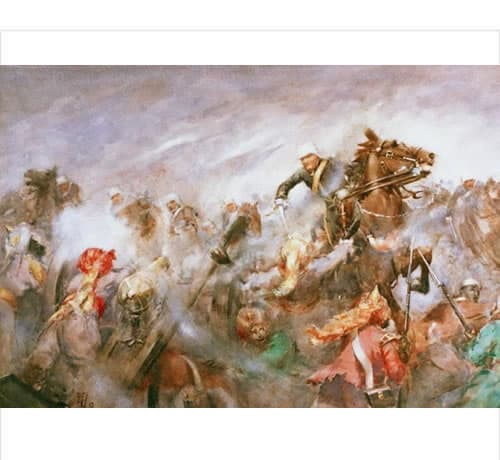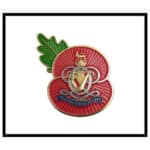The 8th (King’s Royal Irish) Hussars had spent a year in England after the Crimean War before being called to India to help suppress the Indian Rebellion of 1857 and by February 1858 they were ready for war.
The most celebrated action of the war came three months later at Gwalior when ‘A’ squadron of the 8th, under Captain Heneage, fought a large Indian force under Rani Lakshmibai trying to leave the area.
The 8th Hussars charged into the enemy, killing swathes of Indian soldiers, taking two guns and continuing the charge right through the Phul Bagh encampment.
Rani Lakshmibai, the Queen of Jhansi state, dressed as a cavalry leader, was badly wounded. She did not want the British to capture her body, so she told a hermit to burn her body.
General Sir Hugh Rose awarded the squadron four Victoria Crosses under Clause 13 of the Victoria Cross warrant. This meant that one officer, one NCO, and two for the Corporals and troopers, all to be elected by their comrades.
Captain C W Heneage, Sergeant J Ward, Farrier G Hollis and Private J Pearson were chosen to be recipients.
The citation was published in the London Gazette on 28 January 1859 and read:
War-Office, 26th January 1859.
The Queen has been graciously pleased to confirm the grant of the Decoration of the Victoria Cross to the undermentioned Officer, Non-Commissioned Officer, Farrier, and Private of Her Majesty’s 8th Hussars, which decoration has been provisionally conferred upon them by Major-General Sir Hugh Henry Rose, G.C.B., Commanding the Central India Field Force, in accordance with the rules laid down in Her Majesty’s Warrant instituting the same, on account of an Act of Bravery performed by them in India, as recorded against their several names, viz.:
Captain (now Brevet-Major) Clement Walker Heneage, No. 1584. Serjeant Joseph Ward, No. 1298. Farrier George Hollis, No. 861. Private John Pearson
Date of Act of Bravery, 17th June 1858.
Selected for the Victoria Cross by their companions in the gallant charge made by a squadron of the Regiment at Gwalior, on 17 June 1858, when, supported by a division of the Bombay Horse Artillery, and Her Majesty’s 95th Regiment, they routed the enemy, who were advancing against Brigadier Smith’s position, charged through the rebel camp into two batteries, capturing and bringing into their camp two of the enemy’s guns, under a heavy and converging fire from the Fort and Town.
The remaining year of the Mutiny consisted of the pursuit of the rebel forces. On 5 September 1858, a squadron of “D” Troop, 8th Hussars, caught the mutineers at Beejapore, inflicting heavy losses. Of the 850 enemy troops, no less than 450 bodies were counted dead on the field. On 8 September 1858 at Beejapore, when both the officers attached to the troop were disabled, Troop Sergeant-Major James Champion, although severely wounded himself at the start of the action, continued to do his duty and wounded several of the enemy.
For this action, he too was awarded the Victoria Cross.
From then on, until 21 May 1859, when the Headquarters Troop reached Nusserabad, all troops had been in search of the rebels. In its time in India, the 8th had gone through two hot-weather campaigns, H.Q. Troop had shifted camp 300 times and marched over 3000 miles with some of the other Troops marching close to 4000 miles. Reaching Meerut in February 1861, there was an epidemic of cholera in which the regiment lost two officers and thirty-one men.
In 1863, the 8th were reduced to seven service troops and five hundred horses and received orders to embark for England in November. Allowed to give volunteers to only three other units, 133 men went to the 19th Hussars, 54 to the 20th Hussars, and 6 to the Queen’s Bays. All the horses and saddlery were handed over to the 5th Lancers.



